Pit boss PRO PBV4PS1 User Manual
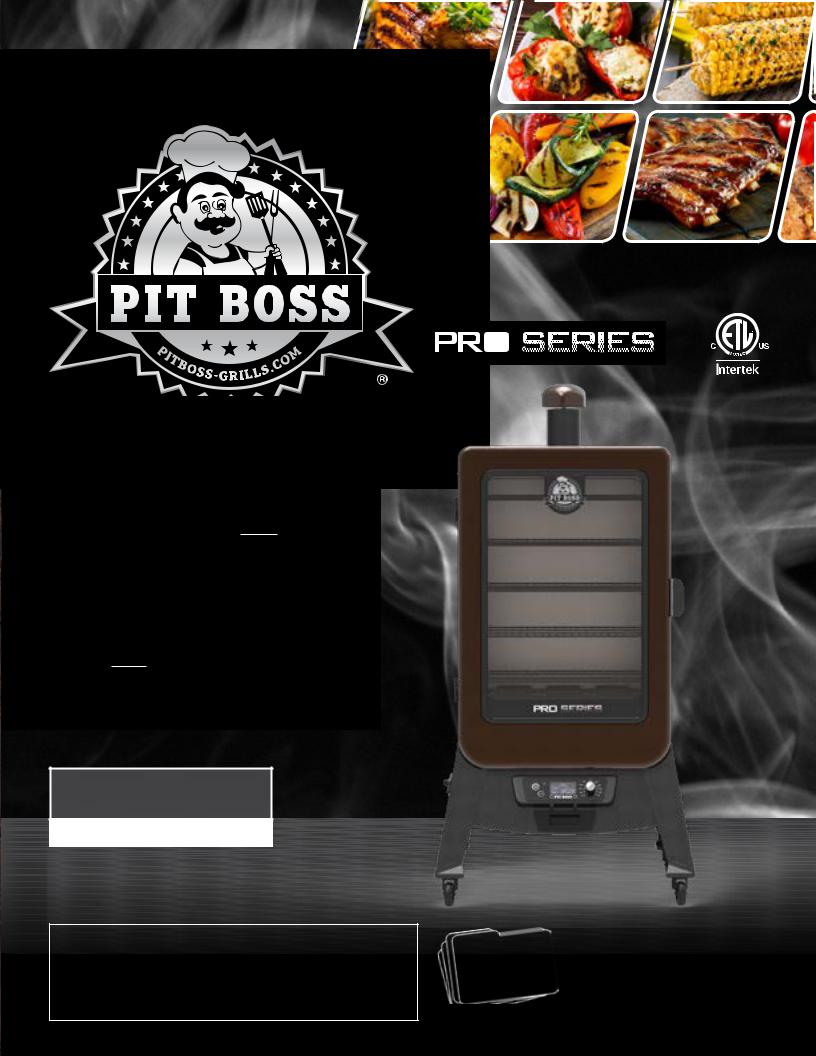
ITM. / ART. 0817531
MODEL / MODÈLE / MODELO: PBV4PS1
PART / PIÈCE / PARTE: 72780
5005166
UL SUB.2728
WOODPELLET
SMOKER
IMPORTANT, READ CAREFULLY, RETAIN FOR
FUTURE REFERENCE. MANUAL MUST BE READ
BEFORE OPERATING!
AHUMADOR CON
PELLETS DE MADERA
IMPORTANTE, LEA DETENIDAMENTE,
CONSERVE PARA REFERENCIA
FUTURA. ¡DEBE LEER EL MANUAL
ANTES DE LA OPERACIÓN!
PBV4PS1
65-215°C / 150-420°F
ASSEMBLY AND OPERATION MONTAJE Y OPERACIÓN
WARNING: Please read the entire manual before installation and use of this electric, pellet fuel-burning appliance. Failure to follow these instructions could result in property damage, bodily injury or even death. Contact local building or fire officials about restrictions and installation inspection requirements in your area.
ADVERTENCI: Lea el manual completo antes de instalar y utilizar este aparato eléctrico para quemar pellets de combustible. Incumplir estas instrucciones podría causar daños materiales, lesiones corporales, e incluso la muerte. Consulte a sus funcionarios locales de construcción y control de incendios para informarse sobre las restricciones y los requisitos de inspección de instalaciones en su región.
RECIPES |
INCLUDED |
|
INCLUIDAS |
||
RECETAS |
||
|
FOR OUTDOOR AND HOUSEHOLD USE ONLY. NOT FOR COMMERCIAL USE.
SÓLO PARA USO EXTERIOR Y EN EL HOGAR. NO ES PARA USO COMERCIAL.
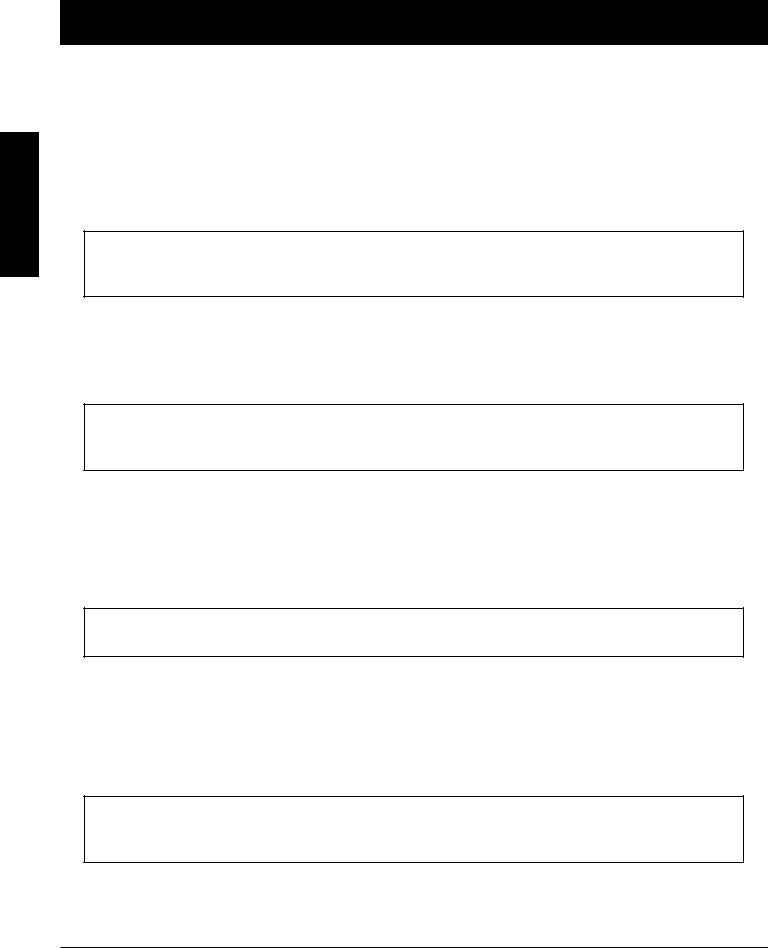
ENGLISH
SAFETY INFORMATION
MAJOR CAUSES OF APPLIANCE FIRES ARE A RESULT OF POOR MAINTENANCE AND A FAILURE TO MAINTAIN REQUIRED CLEARANCE TO COMBUSTIBLE MATERIALS. IT IS OF UTMOST IMPORTANCE THAT THIS PRODUCT BE USED ONLY IN ACCORDANCE TO THE FOLLOWING INSTRUCTIONS.
Please read and understand this entire manual before attempting to assemble, operate or install the product. This will ensure you receive the most enjoyable and trouble-free operation of your new wood pellet grill. We also advise you retain this manual for future reference.
DANGERS AND WARNINGS
You must contact your local home association, building or fire officials, or authority having jurisdiction, to obtain the necessary permits, permission or information on any installation restrictions, such as any grill being installed on a combustible surface, inspection requirements or even ability to use, in your area.
1.A minimum clearance of 305mm (12 inches) from combustible constructions to the sides of the smoker, and 305mm (12 inches) from the back of the smoker to combustible constructions must be maintained. Any limitations joining of two or more parts to constitute an assembly, such as installation of support legs, enclosures and the like. Do not use this appliance indoors, in an enclosed unventilated area, under an overhead combustible ceiling or overhang. Keep your smoker in an area clear and free from combustible materials, gasoline and other flammable vapors and liquids.
Should a grease fire occur, turn the grill off and leave the lid closed until the fire is out. Do not unplug the power cord. Do not throw water on. Do not try to smother the fire. Use of an all-class (class ABC) approved fire extinguisher is valuable to keep on site. If an uncontrolled fire does occur, call the Fire Department.
2.Keep electrical supply cords and the fuel away from heated surfaces. Do not use your grill in the rain or around any water source.
3.After a period of storage, or non-use, check the burn grate for obstructions, the hopper for foreign objects, and any air blockage around the fan intake or rear barrel exhaust holes. Clean before use. Regular care and maintenance is required to prolong the lifespan of your unit. If the grill is stored outside during the rainy season or seasons of high humidity, care should be taken to insure that water does not get into the hopper. When wet or exposed to high humidity, wood pellets will expand greatly, decompose, and may jam the feed system. Always disconnect the power, before performing any service or maintenance.
Do not transport your grill while in use or while the grill is hot. Ensure the fire is completely out and that the grill is completely cool to the touch before moving.
4.It is recommended to use heat-resistant barbecue mitts or gloves when operating the grill. Do not use accessories not specified for use with this appliance. Do not put a barbecue cover or anything flammable in the storage space area under the barbecue.
Parts of the barbecue may be very hot, and serious injury may occur. Keep young children and pets away while in use.
5.To prevent fingers, clothing or other objects from coming in contact with the auger feed system, the appliance is equipped with a metal safety screen, mounted to the interior of the hopper. This screen must not be removed unless directed by Customer Service or an authorized dealer.
This appliance is not recommended for children, persons with reduced physical, sensory or mental capabilities, or lack of experience and knowledge, unless they are under direct supervision or instruction by a person responsible for their safety.
6.Do not enlarge igniter holes or burn pots. Failure to follow this warning could lead to a fire hazard and bodily harm and will void your warranty.
7.Product may have sharp edges or points. Contact may result in injury. Handle with care.
2
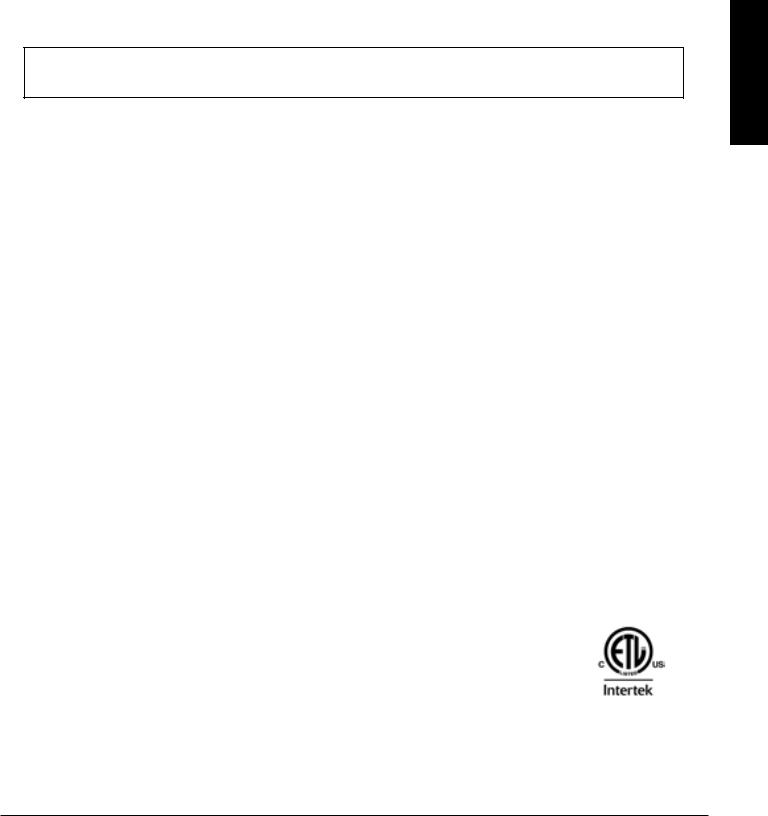
DISPOSAL OF ASHES
Ashes should be placed in a metal container with a tight-fitting lid. The closed container of ashes should be placed on a noncombustible floor or on the ground, well away from all combustible materials, pending final disposal. When ashes are disposed by burial in soil, or otherwise locally dispersed, they should be retained in a closed container until all cinders have thoroughly cooled.
WOOD PELLET FUEL
This pellet cooking appliance is designed and approved for pelletized, all natural, wood fuel only. Any other type of fuel burned in this appliance will void the warranty and safety warning. You must only use all natural wood pellets, designed for burning in pellet barbecue grills. Do not use fuel labelled as having additives.
Do not use lava rock, wood chunks, charcoal, spirit, petrol, gasoline, lighter-fluid or kerosene for lighting or refreshing a fire in your grill. Keep all such substances and liquids well away from appliance when in use.
At this time of printing, there is no industry standard for barbecue wood pellets, although most pellet mills use the same standards to make wood pellets for domestic use. Further information, can be found at www.pelletheat.org or the Pellet Fuel Institute.
Contact your local dealer on the quality of pellets in your area, and for information on brand quality. As there is no control over the quality of pellets used with the appliance, Dansons assumes no liability caused by the quality of fuel.
CREOSOTE
Creosote, or soot, is a tar-like substance. When burning, it produces black smoke with a residue which is also black in color. Soot or creosote is formed when the appliance is operated incorrectly, such as: incorrect position of the burn grate, blockage of the combustion fan, failure to clean and maintain the burn area, or poor air-to-fuel combustion.
It is dangerous to operate this appliance should the flame become dark, sooty, or if the burn pot is overfilled with pellets. When ignited, this creosote makes an extremely hot and uncontrolled fire, similar to a grease fire. Should this happen, turn the unit off, let it cool completely, then inspect for maintenance and cleaning. It commonly accumulates along exhaust areas.
If creosote has formed within the unit; allow the unit to warm up at a low temperature, turn off the appliance, then wipe away any formation with a hand towel. Similar to tar, it is much easier to clean when warm, as it becomes liquid.
CARBON MONOXIDE (“the silent killer”)
Carbon monoxide is a colorless, odorless, tasteless gas produced by burning gas, wood, propane, charcoal or other fuel. Carbon monoxide reduces the blood’s ability to carry oxygen. Low blood oxygen levels can result in headaches, dizziness, weakness, nausea, vomiting, sleepiness, confusion, loss of consciousness or death. Follow these guidelines to prevent this colorless, odorless gas from poisoning you, your family, or others:
•See a doctor if you or others develop cold or flu-like symptoms while cooking or in the vicinity of the appliance. Carbon monoxide poisoning, which can easily be mistaken for a cold or flu, is often detected too late.
•Alcohol consumption and drug use increase the effects of carbon monoxide poisoning.
Carbon monoxide is especially toxic to mother and child during pregnancy, infants, the elderly, smokers, and people with blood or circulatory system problems, such as anemia, or heart disease.
SAFETY LISTING
In accordance with the procedures and specifications listed in the UL SUBJECT 2728-2009 "pellet fuel cooking appliances" and ULC/ORD C272 and CANADIAN CSA C22.2 #3 "for electrical features of fuel burning equipment." Pit Boss pellet cooking appliances have been independently tested and listed by
INTERTEK (an accredited testing laboratory) to ETL, UL, ULC and CSA standards.
ENGLISH
3
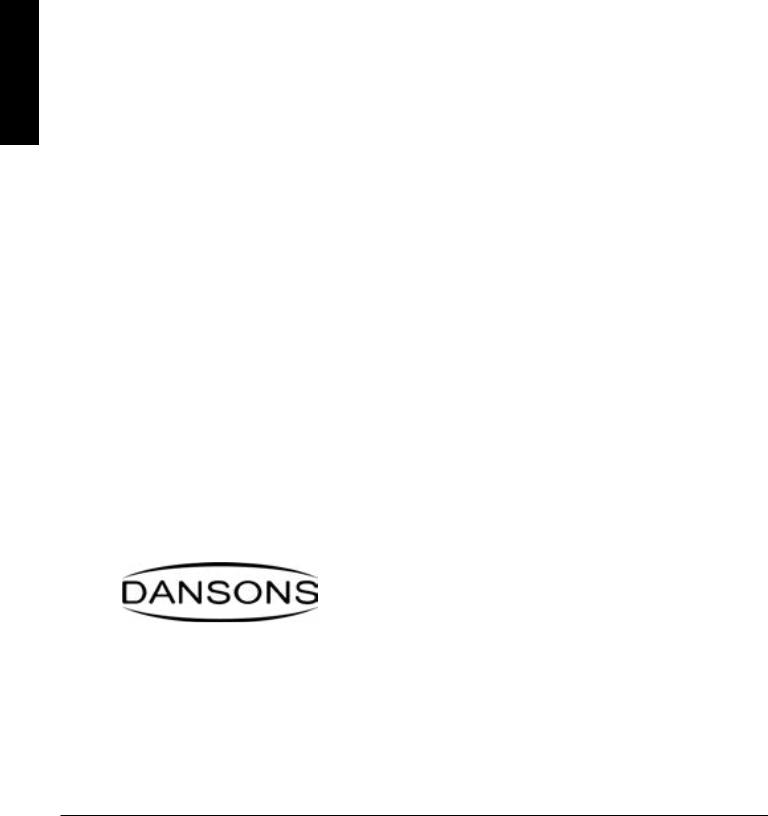
ENGLISH
COPYRIGHT NOTICE
Copyright 2018. All right reserved. No part of this manual may be copied, transmitted, transcribed, stored in a retrieval system, in any form or by any means without expressed written permission of,
Dansons
3411 North 5th Avenue, Suite 500, Phoenix, AZ, USA 85013 sales@pitboss-grills.com | service@pitboss-grills.com www.pitboss-grills.com
Customer Service
Monday through Sunday, 4am - 8pm PST (EN/FR/ES)
Toll-Free: 1-877-303-3134, Fax: 1-877-303-3135
4

TABLE OF CONTENTS
Safety Information ........................................................... |
2 |
Parts & Specs...................................................................... |
6 |
Assembly Preparation...................................................... |
7 |
Assembly Instructions |
|
Mounting The Support Legs To Main Cabinet........................ |
7 |
Securing The Control Panel To Support Legs.......................... |
7 |
Mounting The Support Panels................................................... |
8 |
Securing The Support Bar........................................................... |
8 |
Mounting The Grease Exhaust Tube........................................ |
8 |
Attaching The Heat Shield.......................................................... |
8 |
Mounting The Power Cord Bracket........................................... |
9 |
Securing The Grease Tray Brackets........................................... |
9 |
Placing The Grease Tray............................................................... |
9 |
Attaching The Hopper Clean-Out Door Knob......................... |
9 |
Mounting The Back Handle...................................................... |
10 |
Securing The Chimney............................................................... |
10 |
Installing The Lid Stopper......................................................... |
10 |
Mounting The Cabinet Door Handle, Door Latch................ |
10 |
Installing The Cooking Components ...................................... |
11 |
Connecting To A Power Source................................................. |
11 |
Operating Instructions |
|
Smoker Environment.................................................................. |
12 |
Smoker Temperature Ranges.................................................... |
13 |
Understanding The Control Board.......................................... |
14 |
Understanding The Probes....................................................... |
14 |
Hopper Priming Procedure....................................................... |
15 |
First Use – Smoker Burn-Off.................................................... |
15 |
Preheating..................................................................................... |
15 |
Automatic Start-Up Procedure................................................ |
15 |
Manual Start-Up Procedure..................................................... |
16 |
Shutting Off Your Smoker......................................................... |
16 |
Care & Maintenance......................................................... |
17 |
Using Wood Pellet Fuel.................................................. |
18 |
Cooking Guidelines.......................................................... |
18 |
Tips & Techniques............................................................ |
20 |
Troubleshooting ............................................................... |
21 |
Electrical Wire Diagram.................................................. |
23 |
Replacement Parts |
|
Smoker Replacement Parts ..................................................... |
24 |
Electrical Replacement Parts.................................................... |
25 |
Warranty |
|
Conditions..................................................................................... |
25 |
Exceptions.................................................................................... |
26 |
Ordering Replacement Parts.................................................... |
26 |
Contact Customer Service......................................................... |
26 |
Warranty Service ........................................................................ |
26 |
Accessories Sold Separately.......................................... |
27 |
Recipes............................................................................... |
28 |
ENGLISH
5
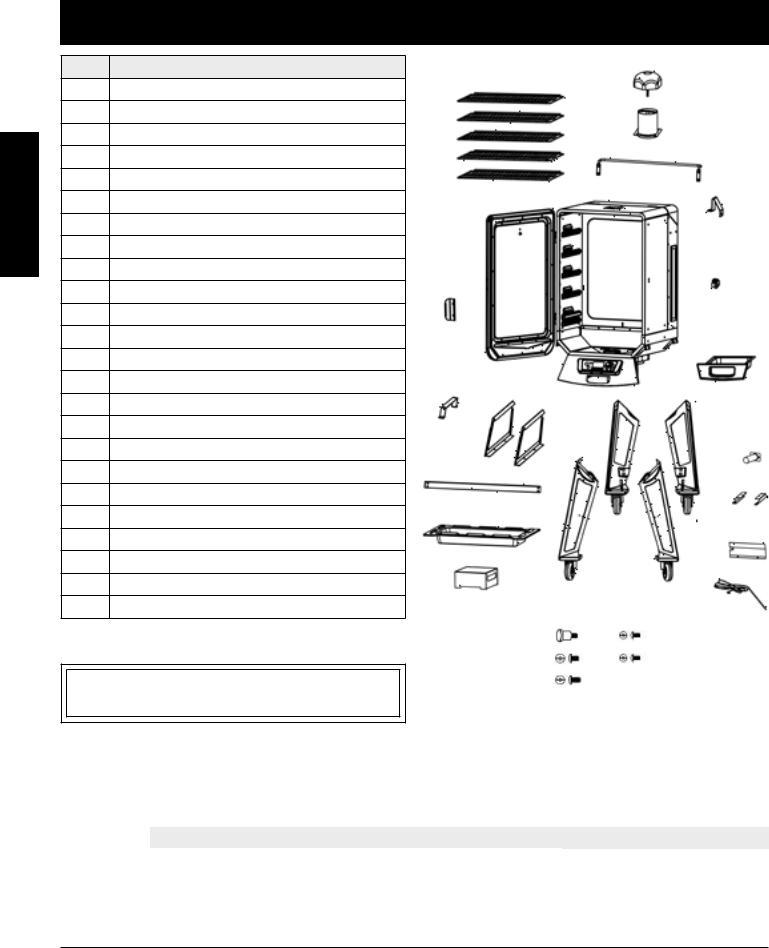
ENGLISH
PARTS & SPECS
Part# Description
1 Cooking Grids (x5)
2Chimney Cap (x1)
3Chimney Stack (x1)
4Hopper Handle (x1)
5Lid Stopper (x1)
6Main Cabinet (x1)
7Cabinet Door Handle (x1)
8Cabinet Door Latch (x1)
9Power Cord Bracket (x1)
10 Support Panel (x2)
11 Support Bar (x1)
12 Water Pan (x1)
13 Flame Tamer (x1)
14 Support Leg With Wheel (x4)
15 Grease Tray (x1)
16 Grease Exhaust Tube (x1)
17 Grease Tray Brackets (x2)
18 Heat Shield (x1)
19 Meat Probe (x1) A Door Knob (x1)
B ¼–20x½" Screw (x12) C ¼–20x⅝" Screw (x4)
D #10–24x½" Screw (x32) E #10–24x⅓" Screw (x2)
NOTE: Due to ongoing product development, parts are subject to change without notice. Contact
Customer Service if parts are missing when assembling the unit.
PB – ELECTRIC REQUIREMENTS
120V, 2.1AMP, 60HZ, 250W, 3-PRONG GROUNDED PLUG
1 |
2 |
3
4
|
|
|
5 |
6 |
|
|
|
|
|
|
8 |
7 |
|
|
|
|
|
|
15 |
9 |
|
|
|
10 |
|
|
|
|
|
14 |
16 |
|
|
|
|
11 |
|
|
17 |
|
|
|
|
12 |
|
14-2 |
17-1 17-2 |
|
|
14-4 |
|
|
|
|
18 |
13 |
|
|
19 |
14-1 |
|
14-3 |
|
|
|
|
|
|
A |
D |
|
|
B |
E |
|
|
C |
|
|
|
|
|
|
MODEL |
UNIT ASSEMBLED (WxHxD) |
UNIT WEIGHT |
COOKING AREA |
TEMP. RANGE |
DIGITAL FEATURES |
|
|
|
|
|
|
|
Ten temperature |
PB |
PBV4PS1 |
681mm x 1,341mm x 657mm |
51.0 kg |
Cubic Cooking: 0.09 m3 / 3.5 ft3 |
65-215°C |
presets, start-up and |
/ 26.8" x 52.8" x 25.9" |
/ 112.2 lb |
TOTAL - 8,387 cm² / 1,300 sq. in. |
/ 150-420°F |
cool-down cycles, |
||
|
|
|
|
|
|
electric igniter |
|
|
|
|
|
|
|
6

ASSEMBLY PREPARATION
Parts are located throughout the shipping carton, including underneath the grill. Inspect the grill, parts, and hardware blister pack after removing from the protective shipping carton. Discard all packaging materials from inside and outside of the grill before assembly, then review and inspect all parts by referencing the parts list. If any part is missing or damaged, do not attempt to assemble. Shipping damage is not covered under warranty. Contact your dealer or Pit Boss Customer Service for parts: Monday through Sunday, 4am - 8pm PST (EN/FR/ES).
service@pitboss-grills.com | Toll-Free: 1-877-303-3134 | Toll-Free Fax: 1-877-303-3135
IMPORTANT: To ease installation, using two people is helpful (but not necessary) when assembling this unit.
Tools required for assembly: screwdriver and level. Tools not included.
ASSEMBLY INSTRUCTIONS
IMPORTANT: It is advised to read each step entirely before starting assembly on instructions. Do not tighten screws completely until all screws for that step have been installed, or unless otherwise mentioned.
1. MOUNTING THE SUPPORT LEGS TO MAIN CABINET |
1A |
6 |
1B |
|
||
Parts Required: |
|
|||||
|
|
14-1 |
14-3 |
|||
1 |
x |
Main Cabinet (#6) |
|
|
|
|
4 |
x Support Leg With Wheel (#14) |
|
|
|
|
|
12 |
x |
¼–20x½" Screw (#B) |
|
|
|
|
Installation: |
|
|
|
|
||
• |
Place a piece of cardboard on the floor to prevent scratching the unit |
|
|
14-2 |
14-4 |
|
|
and parts during assembly. First, lift the main cabinet door off the |
1C |
|
|
|
|
|
hinges, and place aside. Note illustration 1A |
|
14-3 |
|
||
|
|
|
|
|||
• |
Next, flip the main cabinet, bottom side pointed upward, on the |
|
|
B |
14-4 |
|
|
cardboard. Prepare the four support legs for installation, arranging |
|
|
|||
|
|
|
|
|
||
|
the labelled legs as shown in illustration 1B. |
|
|
|
B |
|
IMPORTANT: The four support legs must be arranged correctly to be |
|
14-1 |
|
|
||
able to properly install the support panels and support bar in a later |
|
|
|
|
||
assembly step. |
|
B |
|
|
||
• |
Mount one support leg to the smoke cabinet using three screws. Repeat |
|
|
|
||
|
|
B |
14-2 |
|||
|
installation for the other three support legs. Note illustration 1C. |
|
|
|||
|
|
|
|
|||
2. SECURING THE CONTROL BOARD TO SUPPORT LEGS |
2 |
|
|
|
||
Parts Required: |
|
|
|
|||
|
2A |
|
|
|||
2 |
x |
#10–24x½" Screw (#D) |
|
|
|
|
Installation: |
|
|
D |
|
||
• |
Near the Control Board, loosen the two screws connecting the front |
|
|
|
||
|
|
|
|
|||
|
panel to the main cabinet. Note 2A. |
|
|
|
2B |
|
• |
Next, using another two screws, secure the front panel sides to the |
|
D |
|
||
|
|
|
||||
|
|
|
|
|||
|
front-facing support legs. Once these screws are tight, re-tighten the |
|
|
|
|
|
|
two screws that were previously loosened. Note 2B. |
|
|
|
|
|
|
|
|
|
|
|
7 |
ENGLISH
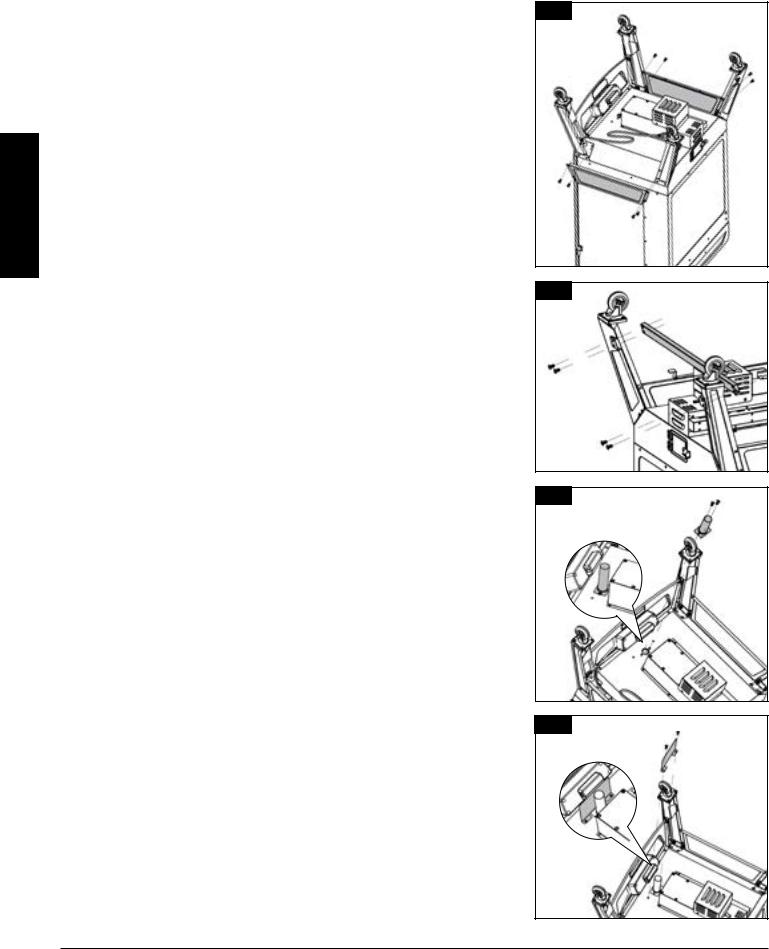
ENGLISH
3. MOUNTING THE SUPPORT PANELS
Parts Required:
2 |
x |
Support Panel (#10) |
8 |
x |
#10–24x½" Screw (#D) |
Installation:
•Install one support panel to the side of the unit between a front and back support leg. Secure using two screws on each side. Ensure the flat side of the support plate is facing outwards. Repeat the same installation to mount the other support panel. Note illustration for support panel arrangement.
NOTE: The support panel with two holes along the bottom should be on the same side of the unit as the power cord exits the control board (left side). This is important for later steps.
4. SECURING THE SUPPORT BAR
Parts Required:
1 |
x |
Support Bar (#11) |
4 |
x |
#10–24x½" Screw (#D) |
Installation:
•Install the support bar to the rear of the unit between the two rear support legs. Secure using two screws on each side. Ensure the support bar is placed on the underside of the main cabinet, facing inwards.
Note illustration for support bar arrangement.
5.MOUNTING THE GREASE EXHAUST TUBE
Parts Required:
1x Grease Exhaust Tube (#16)
2x #10–24x⅓" Screw (#E)
Installation:
•Mount the grease exhaust tube to the underside of the main cabinet using two screws.
IMPORTANT: Ensure there is a good seal to the main cabinet, as grease will come from the main cabinet, flow through the exhaust tube, and exit into the grease tray.
6. ATTACHING THE HEAT SHIELD
Parts Required:
1x Heat Shield (#18)
2x #10–24x½" Screw (#D)
Installation:
•Position the heat shield between the control board and the grease exhaust tube. Secure using a screw on each side.
IMPORTANT:Ifthispartisnotinstalledcorrectly,theheatand/orsplatter from the grease exhaust tube may cause damage to the control board. Grease damage to the rear of control board is not covered by warranty.
3 |
|
|
|
|
D |
|
|
10 |
|
|
D |
|
D |
10 |
|
|
|
|
|
D |
4 |
|
|
D |
|
11 |
|
|
|
|
|
D |
5 |
|
E |
|
|
16 |
6 |
|
D |
|
|
|
|
|
18 |
8
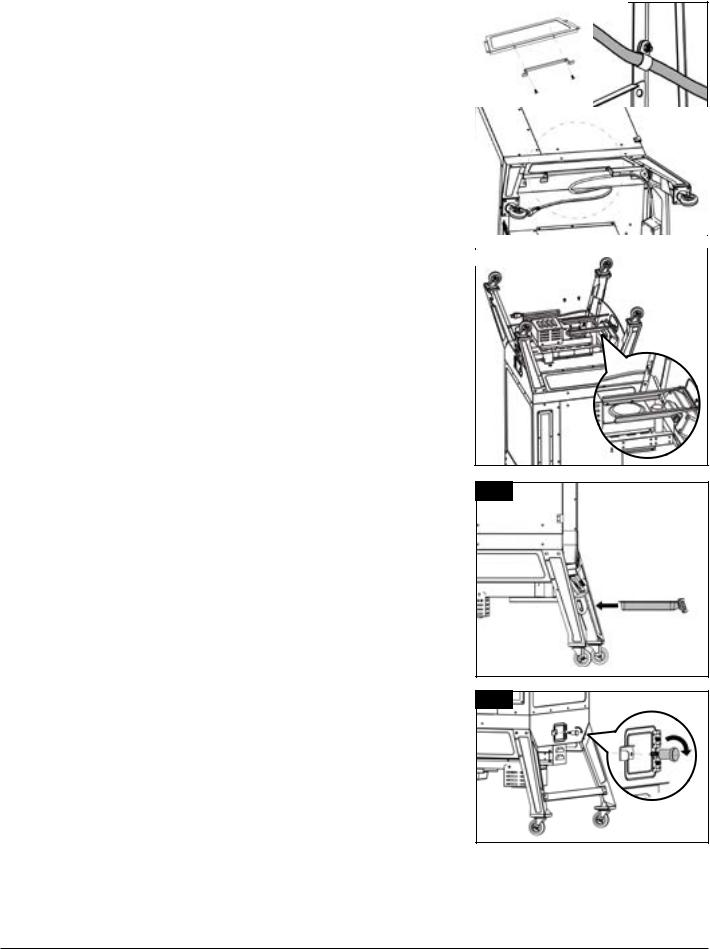
7. MOUNTING THE POWER CORD BRACKET
Parts Required:
1x Power Cord Bracket (#9)
2x #10–24x½" Screw (#D)
Installation:
•Locate the two holes on the bottom of the (left side) support bracket. Mount the power cord bracket to the support bracket using two screws as shown in 7A.
•Next, loosen the nut on the pre-mounted clip bracket and guide the power cord through the clip bracket. Once through, tighten the nut, and wrap the power cord on the bracket until unit is in use. Note 7B, 7C.
8.SECURING THE GREASE TRAY BRACKETS
Parts Required:
2 |
x |
Grease Tray Brackets (#17) |
4 |
x |
#10–24x½" Screw (#D) |
Installation:
•Secure the grease tray brackets onto the base of the auger housing using two screws in each bracket. Note illustration for proper placement.
NOTE: The diveted end of the brackets should face the control board.
•Fully-tighten all screws on the cart base. Next, carefully turn the unit into an upright position, with the wheels are on the bottom.
9.PLACING THE GREASE TRAY
Parts Required:
1 |
x Grease Tray (#15) |
Installation:
•Slide the grease tray into the grease tray brackets on the front underside of the main cabinet, under the control board.
NOTE: The grease tray is completely inserted once the front of the tray is pushed in as far as it can go, with no gap between the grease tray and the front panel.
10. ATTACHING THE HOPPER CLEAN-OUT DOOR KNOB
Parts Required:
1 x Door Knob (#A)
Installation:
•Attach the door knob to the hopper clean-out door by rotating the part into the hole on the door. Rotate until completely fastened and clean-out door latch is secured.
NOTE: To use the hopper clean-out feature, simply loosen the door knob, raise the clean-out door latch and open the door.
7A |
|
7B |
|
|
9 |
|
|
|
D |
|
|
|
D |
|
|
7C |
|
|
|
|
|
|
|
|
|
|
|
9 |
|
|
ENGLISH |
|
|
|
|
||
|
|
|
|
|
|
|
|
|
|
8 |
|
|
|
|
|
|
|
|
|
|
|
D |
||
17-1
17-2
9
15
10 |
A |
9
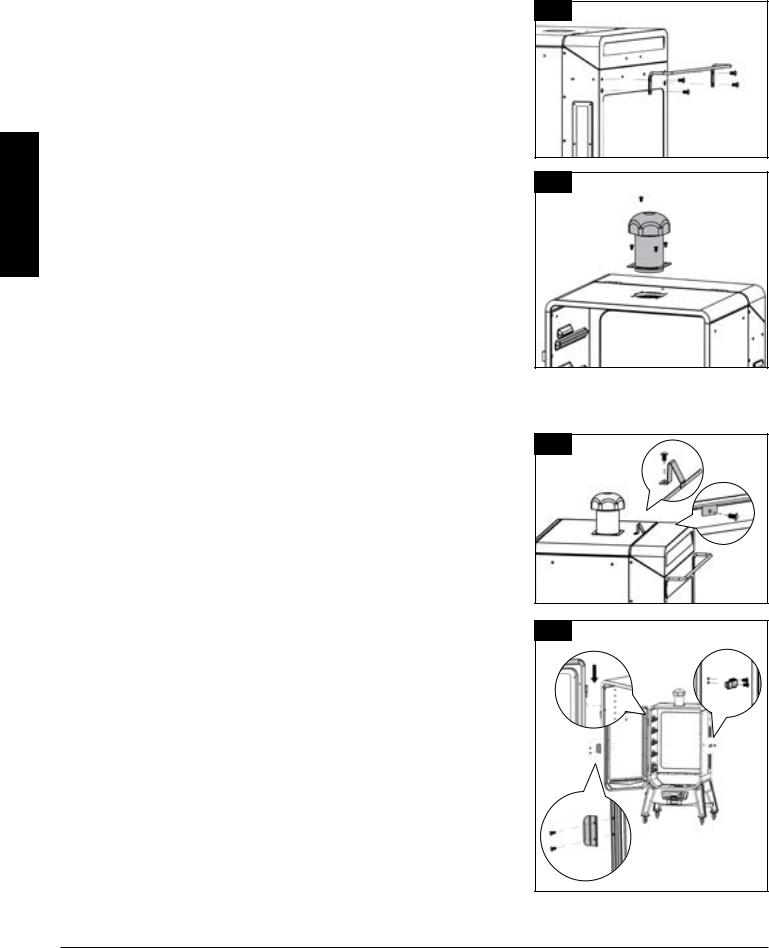
ENGLISH
11. MOUNTING THE BACK HANDLE
Parts Required:
1 |
x |
Hopper Handle (#4) |
4 |
x |
¼–20x⅝" Screw (#C) |
Installation:
•Mount the hopper handle onto the back side of the hopper using four screws (#C). Note correct position in illustration with handle on top.
12.SECURING THE CHIMNEY
Parts Required:
1 |
x |
Chimney Cap (#2) |
1 |
x |
Chimney Stack (#3) |
4 |
x |
#10–24x½" Screw (#D) |
Installation:
•Locate the chimney opening on the top of the main cabinet. From the outside, secure the chimney to the top panel using four screws. The screw will fasten to the self-clinching nut on the inside of the cabinet.
Next, twist the chimney cap onto the top of the chimney stack.
NOTE: Adjust the chimney cap to affect the airflow inside the main grill. If cooking at low temperature, keep the cap more open.
13. INSTALLING THE LID STOPPER
Parts Required:
1x Lid Stopper (#5)
2x #10–24x½" Screw (#D)
Installation:
•Install the lid stopper onto the top of the main cabinet near the hopper lid, using one screw on the top side and one screw on the inside edge between the hopper lid hinges.
14.MOUNTING THE CABINET DOOR HANDLE, DOOR LATCH
Parts Required:
1 |
x Cabinet Door Handle (#7) |
|
1 |
x |
Cabinet Door Latch (#8) |
4 |
x |
#10–24x½" Screw (#D) |
Installation:
•First, remount cabinet door to the main cabinet by aligning and securing both hinges. Ensure the door is mounted correctly by testing it opens freely. Note 14A.
•Mount the cabinet door handle onto the front side of the cabinet door using two screws. Note correct direction in 14B.
•Mount the cabinet door latch onto the exterior side of the main cabinet using two screws. Note 14C.
IMPORTANT: Fine tune and test the cabinet door latches and hooks to ensure they align properly and there is a proper seal while the
11
4
C
C
12 |
D |
|
2
3
13 |
D |
|
|
5 |
|
|
|
|
|
|
D |
14 |
|
|
14A |
|
14C |
|
|
8 |
|
|
D |
7
D
14B
10

door is closed. Poor alignment may result in heat loss and leaks during use.
15. INSTALLING THE COOKING COMPONENTS
Parts Required:
1 |
x |
Flame Tamer (#13) |
1 |
x |
Water Pan (#12) |
5 |
x |
Cooking Grids (#1) |
Installation:
•Place the flame tamer over the burn pot at the bottom of the interior main cabinet. To ensure proper positioning, align the flame tamer into the grooves along the bottom of the base panel. Note illustration 15A.
IMPORTANT: The ventilation windows on the sides of the flame tamer box must not face forward, towards the cabinet door. This may cause damage to the control board if flames are too large.
•Next, insert the water pan into the lowest embossed grid supports of the interior cabinet. Fill your water pan about ¾ full of water.
IMPORTANT: Keep water in the water pan at all times while cooking. It will catch grease and drippings from your cooks and allow for easier clean up. If smoking for an extended period of time, move water pan up higher to allow water to last longer.
•Last, place the cooking grids on the embossed grid supports inside the main cabinet.
•The unit is now completely assembled.
16.CONNECTING TO A POWER SOURCE
NOTE: Before plugging your unit into any electrical outlet, ensure the temperature dial is in the SMOKE position. Disconnect when not in use.
•STANDARD OUTLET
This unit requires 120 volt, 60hz, 250w, 2.1 amp service. It must be a 3-prong grounded plug. Ensure grounded end is not broken off. The control uses a
5 amp, 120 volt, fast-blow fuse to protect the board from the igniter.
•GFCI OUTLETS
This appliance will work on most GFCI outlets, with a recommended size of 15 amp service. If your GFCI outlet is highly sensitive to power surges, it will likely trip during the start-up phase of operation. During the start-up phase, the igniter draws 200-700 watts of electricity which can be too much power for a GFCI outlet to handle. The quality of the GFCI does not matter, but rather the sensitivity; each time it trips, it increases in sensitivity. If the GFCI keeps tripping, replace the outlet or change to a non-GFCI outlet.
•ON THE ROAD
Disconnect the igniter from the main wiring harness. Use the manual start-up procedure. A Pit Boss unit can operate using a 12 volt, 100 watt inverter plugged into your automobile outlet. To use the automatic igniter, it is recommended to use a minimum of a 1000 watt inverter.
15A |
|
|
|
13 |
13 |
|
|
15B |
|
ENGLISH |
|
1 |
1 |
||
1 |
|||
1 |
|||
1 |
|
||
12 |
|
||
|
|
||
16 |
|
|
FAST-BLOW FUSE, 5 AMP
11

ENGLISH
OPERATING INSTRUCTIONS
With today’s lifestyle of striving to eat healthy and nutritious foods, a factor to consider is the importance of reducing fat intake.
One of the best ways to cut down on fat in your diet is to use a low fat method of cooking, such as smoking. As a pellet smoker uses natural wood pellets, the savory wood flavor is cooked into the meats, reducing the need for high sugar-based sauces.
SMOKER ENVIRONMENT
1. WHERE TO SET-UP THE SMOKER
With all outdoor appliances, outside weather conditions play a big part in the performance of your smoker and the cooking time needed to perfect your meals. The Pit Boss, because of its double wall construction, should be considered as a 3 season smoker, depending on where you live. All Pit Boss units should keep a minimum clearance of 305mm (12 inches) from combustible constructions, and this clearance must be maintained while the smoker is operational. This appliance must not be placed under overhead combustible ceiling or overhang. Keep your smoker in an area clear from combustible materials, gasoline and other flammable vapors and liquids.
2. COLD WEATHER COOKING
As it becomes cooler outside, that does not mean that grilling season is over! The crisp cool air and heavenly aroma of smoked foods will help cure your winter blues. Follow these suggestions on how to enjoy your smoker throughout the cooler months:
•If smoking at low temperatures fails, increase the temperature slightly to achieve the same results.
•Organize – Get everything you require ready in the kitchen before you head outdoors. During the winter, move your smoker to an area that is out of the wind and direct cold. Check local bylaws regarding the proximity of your smoker in relation to your home and/or other structures. Put everything you need on a tray, bundle up tight, and get it done!
•To help keep track of the outside temperature, place an outdoor thermometer close to your cooking area. Keep a log or history of what you cooked, the outdoor temperature, and the cooking time. This will help later down the road to help you determine what to cook and how long it will take.
•In very cold weather, increase your preheating time by at least 20 minutes.
•Avoid opening the smoke cabinet door any more than necessary. Cold gusts of wind can completely cool your internal temperature. Be flexible with your serving time; add about 10 – 15 minutes extra cooking time each time you open the door.
•Have a heated platter or a dish cover ready to keep your food warm while making the trip back inside.
•Ideal foods for winter cooking are those that require little attention, such as roasts, whole chickens, ribs, and turkey.
Make your meal preparation even easier by adding simple items such as vegetables and potatoes.
3.HOT WEATHER COOKING
As it becomes warmer outdoors, the cooking time will decrease. Proper dress is important when it gets really hot: shorts, shirt, shoes, hat, apron and a generous slab of suntan lotion is recommended. Follow these few suggestions on how to enjoy your smoker throughout the hot months:
•Adjust your cooking temperatures downward. This helps to avoid unwanted flare-ups.
•Use a meat thermometer to determine the internal temperature of your foods. This helps in preventing your meat from over cooking and drying out.
•Even in hot weather, keep the smoke cabinet door closed at all times.
•You can keep foods hot by wrapping them in foil, and placing them in an insulated cooler. Stuff crumpled up newspaper around the foil and this will keep food hot for 3 to 4 hours.
12

SMOKER TEMPERATURE RANGES
Temperature readouts on the control board may not exactly match the thermometer. All temperatures listed below are approximate and are affected by the following factors: outside ambient temperature, the amount and direction of wind, the quality of pellet fuel being used, the cabinet door being opened, and the quantity of food being cooked.
•HIGH TEMPERATURE (190-215°C / 375-420°F)
This range is used to grill at high heat, without any contact with flame. High temperature is also used as the burn-off temperature to clean off the cooking grids after use. Additionally, high heat can be used in extreme cold weather conditions to compensate for the contrast of temperatures between outside and inside the unit.
•MEDIUM TEMPERATURE (135-177°C / 275-350°F)
This range is best for baking, roasting, and finishing off that slow smoked creation. Cooking at these temperatures will greatly reduce the chances of a grease flare-up. Great range for cooking anything wrapped in bacon, or where you want versatility with control.
•LOW TEMPERATURE (65-122°C / 150-250°F)
This range is used to slow roast, increase smoky flavor, and to keep foods warm. Infuse more smoke flavor and keep your meats juicy by cooking longer at a lower temperature (also known as low and slow). Highly recommended for the big turkey at Thanksgiving, juicy ham at Easter, or the huge holiday feast.
Smoking is a variation on true barbecuing and is truly the main advantage of a smoker. There are two types of smoking: hot smoking and cold smoking.
•Hot smoking, another name for low and slow cooking, is generally done at 82-122oC / 180-250oF. Hot smoking works best when longer cooking time is required, such as large cuts of meats, fish, or poultry.
•Cold smoking is when the food is located so far away from the fire that it smokes without cooking, and at temperatures of 15-32oC / 60-90oF.
TIP: To intensify that savory flavor, switch to SMOKE (low) temperature range immediately after putting your food on the smoker. This allows the smoke to penetrate the meats, before the pores of the meat close at 49°C / 120°F.
The key is to experiment with the length of time you allow for smoking, before the meal is finished cooking. Some outdoor chefs prefer to smoke at the end of a cook, allowing the food to keep warm until ready to serve. Practice makes perfect!
ENGLISH
13
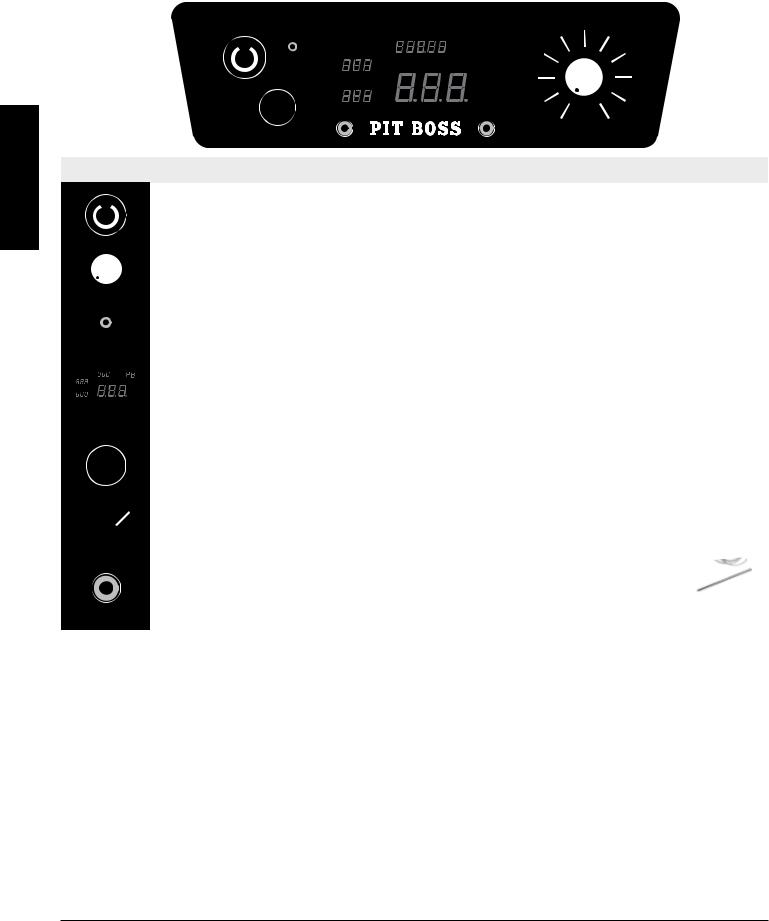
ENGLISH
UNDERSTANDING THE CONTROL BOARD
|
|
|
|
|
|
|
|
|
|
|
|
|
|
|
|
|
225º |
250º |
275º |
|
|
|
|
|
|
|
|
|
|
|
F / C |
|
|
COOK |
|||||
|
|
|
|
|
|
|
|
|
|
|
|
|
|
|
|
||||
|
|
|
|
|
|
|
|
|
|
|
|
PROBE 1 |
FC |
FC |
|
|
200º |
|
300º |
|
|
|
|
|
|
|
|
|
|
|
|
|
|||||||
|
|
|
|
|
|
|
|
|
|
|
|
|
|
|
|
||||
|
|
|
|
|
|
|
|
|
|
|
|
|
ACTUAL |
|
|
|
|||
|
|
|
|
|
|
|
|
|
|
|
|
|
|
|
|
|
|||
|
|
|
|
|
|
|
|
|
|
|
|
PROBE 2 |
FC |
|
FC |
|
175º |
|
350º |
|
|
|
|
|
|
|
|
|
|
|
|
|
|
150º |
|
400º |
|||
|
|
|
|
|
|
|
|
|
|
|
|
|
|
|
|
|
|||
|
|
|
|
|
|
|
|
|
|
|
PRIME |
|
|
|
|
|
|
||
|
|
|
|
|
|
|
|
|
|
|
|
|
|
|
|||||
|
|
|
|
|
|
|
|
|
|
|
|
|
|
|
|
|
SMOKE |
|
HIGH |
|
|
|
|
|
|
|
|
|
|
|
|
|
|
|
|
|
|
|
|
CONTROL |
DESCRIPTION |
|
|
|
|
|
|
|
|||||||||||
|
|
|
|
|
|
|
|
|
Press the Power Button to power on the unit. Once connected to a power source and the Power Button is |
||||||||||
|
|
|
|
|
|
|
|
|
|||||||||||
|
|
|
|
|
|
|
|
|
pressed, the Digital LED Screen with light up, displaying that it is ready to operate. Press and hold the button |
||||||||||
|
|
|
|
|
|
|
|
|
|||||||||||
|
|
|
|
|
|
|
|
|
to turn the unit off. |
|
|
|
|
|
|
|
|||
|
|
|
|
|
|
|
|
|
|
|
|
|
|
|
|
|
|||
|
|
|
|
|
|
|
|
|
The Temperature Control Dial allows you to set your desired smoking temperature. Select from any of the |
||||||||||
|
|
|
|
|
|
|
|
|
ten preset temperatures on the dial control, between 65-215°C / 150-420°F. |
|
|
||||||||
|
|
|
|
|
|
|
|
|
|
|
|
|
|
|
|
|
|||
|
|
|
|
F / C |
|
|
The Temperature Switch Button is used to change the temperature readout on the LED Screen. Press the |
||||||||||||
|
|
|
|
|
|
|
|
|
button to switch to Celsius (ºC) or to Fahrenheit (ºF), as preferred. Default is set to Fahrenheit. |
||||||||||
|
|
|
|
|
|
|
|
|
|
|
|
|
|
|
|
|
|||
|
|
|
|
|
|
|
|
|
The Digital LED Screen is used as the information center for your unit. The LED screen will display your |
||||||||||
|
|
|
|
COOK |
“P” SET |
|
Desired Cook Temperature, Actual Cook Temperature, and Meat Probe Temperatures (if connected). If only |
||||||||||||
|
PROBE 1 |
|
|
|
FC |
|
|
||||||||||||
|
FC |
|
|
|
|
|
|||||||||||||
|
PROBE 2 |
|
ACTUAL |
FC |
|
one Meat Probe is connected, only one reading will be displayed. Temperature can be displayed in either |
|||||||||||||
|
|
|
|
|
|||||||||||||||
|
|
|
FC |
|
|
|
|
|
|||||||||||
|
|
|
|
|
|
|
|
|
Fahrenheit or Celsius. |
|
|
|
|
|
|
|
|||
|
|
|
|
|
|
|
|
|
|
|
|
|
|
|
|
||||
|
|
|
|
|
|
|
|
|
|
|
|
|
|
|
|
|
|||
|
|
|
|
|
|
|
|
|
Press and hold the Prime Button to activate an extra feed of pellets to the burn pot. This can be used to add |
||||||||||
|
|
|
PRIME |
|
|
more fuel to the fire just before opening the smoke cabinet door, resulting in a quicker heat recovery time. It |
|||||||||||||
|
|
|
|
|
can also be used to add more fuel while smoking, to increase the intensity of clean smoke flavor. Requested |
||||||||||||||
|
|
|
|
|
|
|
|
|
from the competition cookers. |
|
|
|
|
|
|
|
|||
|
|
|
|
|
|
|
|
|
|
|
|
|
|
|
|
|
|||
|
|
|
|
|
|
|
|
|
The Smoke Setting on the Temperature Control Dial is the start-up mode for the unit. The smoker operates |
||||||||||
|
|
|
|
|
|
|
|
|
|||||||||||
|
|
SMOKE |
|
|
at the lowest temperature, without the fire going out. |
|
|
|
|||||||||||
|
|
|
|
|
|
|
|
|
|
|
|
|
|
|
|
|
|||
|
|
|
|
|
|
|
|
|
The plug-in connection port(s) on the front of the Control Board are for a Meat Probe(s). |
||||||||||
|
|
|
|
|
|
|
|
|
When a meat probe is connected, the temperature is displayed on the LED Screen. When not |
||||||||||
|
|
|
|
|
|
|
|
|
in use, disconnect the meat probe from the connection port. Includes one (1) meat probe. |
||||||||||
|
|
|
|
|
|
|
|
|
Compatible with Pit Boss branded meat probes only. Additional meat probe(s) sold separately. |
||||||||||
|
|
|
|
|
|
|
|
|
|
|
|
|
|
|
|
|
|
|
|
UNDERSTANDING THE PROBES
•TEMPERATURE PROBE
Located inside the cabinet, on the rear wall along the bottom, is the temperature probe. It is a small, vertical piece of stainless steel. The temperature probe measures the internal temperature of the unit. When the temperature is adjusted on the Control Board, the temperature probe will read the actual temperature inside the unit and adjust to the desired temperature.
IMPORTANT: The temperature of your unit is highly affected on ambient outdoor weather, quality of pellets used, flavor of pellets, and the quantity of food being cooked.
•MEAT PROBE
The meat probe measures the internal temperature of your meat in the smoke cabinet, similar to your indoor oven. Plugin the meat probe adapter to the meat probe connection port and insert the stainless steel meat probe into the thickest portion of your meat and the temperature will be displayed on the control board. To ensure the meat probe is connected properly to the connection port, feel and hear it snap into place.
14

IMPORTANT: When placing the meat probe into your meat, ensure the meat probe and meat probe wires avoid direct contact with flame or excess heat. This can result in damage to your meat probe. Run the excess wire out the front main cabinet door, along the edge. When not in use, disconnect from the meat probe connection port, and place aside to keep it protected and clean.
HOPPER PRIMING PROCEDURE
These instructions should be followed the first time the smoker is ignited, and each time the smoker runs out of pellets in the hopper. The auger must be primed to allow pellets to travel through the length of the auger, and fill the burn pot. If not primed, the igniter will timeout before the pellets are ignited. Follow these steps to prime:
1. |
Open the hopper lid. Make sure there are no foreign objects in the hopper or blocking the auger feed system at the bottom. |
ENGLISH |
|
2. |
Remove all cooking components from the interior of the smoker. Locate the burn pot in the bottom of the smoke cabinet. |
||
|
|||
3. |
Plug the power cord into a power source. Press the Power Button to turn the unit ON, and turn the Temperature |
|
|
|
Control Dial to the SMOKE position. Check the following items: |
|
|
|
• That you can hear the auger turning. Place your hand above the burn pot and feel for air movement. Do not place |
|
|
|
your hand or fingers inside the burn pot. This can cause injury. |
|
|
|
• After approximately a minute, you should smell the igniter burning and begin to feel the air getting warmer in the |
|
|
|
burn pot. The igniter tip does not glow red hot. Do not touch the igniter. This item gets extremely hot and will burn. |
|
|
4. |
Once verified that all electric components are working correctly, press and hold the Power Button to turn the unit OFF. |
|
|
5. |
Fill the hopper with all natural barbecue wood pellets. Monitor the pellet level using the sight-glass along the side. |
|
|
6. |
Press the Power Button to turn the unit ON. Turn the Temperature Control Dial to the SMOKE position. Press and hold |
|
|
|
the Prime Button until you see pellets entering the burn pot from the auger tube. Once pellets begin to drop into the |
|
|
|
burn pot, release the Prime Button. Allow the pellets to ignite and create flame. Once flames are coming out of the burn |
|
|
|
pot, press and hold the Power Button to turn the control board OFF, and let the smoker cool down. |
|
|
7. |
After the smoker has cooled, re-install the cooking components into the main cabinet. The smoker is now ready to use. |
|
FIRST USE – SMOKER BURN-OFF
Once your hopper has been primed and before using your smoker for the first time with food, it is important to complete a burnoff. Start the smoker and operate at the highest heat (177°C / 350°F) with the cabinet door closed for 30 to 40 minutes to burn-off the unit and rid it of any foreign matter.
PREHEATING
It is important to allow your smoker to preheat before adding food to the unit. This allows the smoker and cooking grids to heat up quicker, kill off bacteria and other pathogens leftover from past smoking sessions, and the smoker is then able to maintain its temperature once your food is placed inside the cabinet. Preheat with the smoke cabinet door closed.
IMPORTANT: The outside ambient temperature, weather conditions, and quality of wood pellets will all affect your cooking temperature. Observe the time it takes to reach your desired temperature, and adjust your cooking time as needed.
AUTOMATIC START-UP PROCEDURE
1.Ensure the Temperature Control Dial is in the SMOKE position. Plug the power cord into a grounded power source.
2.Check the burn pot to ensure there is no obstruction for proper ignition. Open the hopper lid. Ensure there are no foreign objects in the hopper or auger feed system entry at the bottom of the cabinet. Fill or top-up the hopper with dry, allnatural barbecue hardwood pellets. Fill the water pan ¾ with water and monitor during your cook; re-fill frequently.
3.Press the Power Button to turn the unit on. This will activate the start-up cycle. The auger feed system will begin to turn, the igniter will begin to glow and the fan will supply air to the burn pot. The smoker will begin to produce smoke while the start-up cycle is taking place. The cabinet door must remain open during the start-up cycle. To confirm the start-up cycle has begun properly, listen for a torchy roar, and notice some heat being produced.
15

ENGLISH
4.Begin to preheat your smoker with the cabinet door closed. Turn the Temperature Control Dial to 177°C / 350°F, to allow the unit to preheat for approximately 15 to 20 minutes.
5.After preheating is complete, you are ready to enjoy your smoker at your desired temperature!
IMPORTANT: When selecting a low or the SMOKE setting after preheating, the auger will continue to turn and feed pellets. This will momentarily raise the temperature, but temperature will eventually decrease and stabilize. Remember, you are trying to regulate a fire, so time is necessary to acheive your desired temperature.
IGNITER FAILURE PROCEDURE
If for any reason your electric igniter fails, check the following steps, or start your smoker using the manual method.
1.Ensure the Temperature Control Dial is in the SMOKE position. Open the cabinet door. Remove the cooking components from inside. Remove all unburnt pellets and ash from the burn pot. Avoid touching the igniter to avoid injury, as it may be extremely hot.
2.Once all cooking components are removed and cleaned, press the Power Button to turn the unit on. Check the following:
•Visually confirm that the igniter is working by placing your hand above the burn pot and feeling for heat.
•Visually confirm that the igniter is protruding approximately 13mm / 0.5 inches in the burn pot.
•Visually confirm that the auger is dropping pellets into the burn pot.
•Confirm that the combustion fan is working by listening for a torchy roar.
3.If any of the above points are not working, follow Troubleshooting instructions.
MANUAL START-UP PROCEDURE
1.Ensure the Temperature Control Dial is in the SMOKE position. Plug the power cord into a grounded power source.
2.Check burn pot to ensure there is no obstruction for proper ignition. Open the hopper lid. Ensure there are no foreign objects in the hopper or auger feed system. Fill hopper with dry, all natural hardwood barbecue pellets.
3.Open the cabinet door. Remove the cooking components to expose the burn pot. Place a generous handful of pellets into the burn pot. Squirt a gelled fire starter, or other appropriate pellet starter, over the top of the pellets. A small amount of solid fuel fire starter, such as one composed of sawdust and wax, or wood shavings, is also appropriate. Add another small amount of pellets over the burn pot.
NOTE: Do not use spirit, petrol, gasoline, lighter-fluid or kerosene for lighting or refreshing a fire in your grill.
4.Light the contents of the burn pot using a long match or long-nosed lighter. Allow the starter to burn for 3 to 5 minutes.
Do not attempt to add more starter into the burn pot. This can cause injury.
5.Quickly and carefully replace the cooking components to the inside of the smoke cabinet. The cabinet door must remain open during the start-up cycle.
6.Continue start-up by following steps three through five of Automatic Start-Up Procedure.
SHUTTING OFF YOUR SMOKER
1.When finished cooking, turn the temperature dial to 177°C / 350°F and close the cabinet door. Let your smoker run for 5 to 10 minutes to go through its normal cleaning method. If you have been preparing foods that are extra greasy, allow the smoker to burn-off for an extra 10 to 20 minutes. This will reduce the chance of causing a grease fire for the next start-up.
2.Once the burn-off is complete, keep the cabinet door closed and turn the temperature dial down to 93°C / 200°F for five minutes to allow any remaining pellets to burn out.
3.After five minutes, with the cabinet door remaining closed, press and hold the Power Button to turn the unit OFF. The smoker will begin its automatic cool-down cycle. The auger system will stop feeding fuel, the flame will burn out, and the fan will continue to run until the cool-down cycle is complete.
16

CARE AND MAINTENANCE
Any Pit Boss unit will give you many years of flavorful service with minimum cleaning. An important step is allowing the smoke cabinet and cooking grids to self-clean by running the smoker at a high temperature for 5 to 10 minutes after each use. Follow these cleaning and maintenance tips to service your smoker:
1. |
HOPPER ASSEMBLY |
|
|
|
|
|
|
|
|
|
|
|
|
||
|
• The hopper includes a clean-out feature to allow for ease of cleaning and change |
|
|
|
|||
|
out of pellet fuel flavors. To empty, locate the clean-out door of the drop chute on |
|
|
ENGLISH |
|||
|
the back side of the hopper. Place a clean, empty pail under the clean-out door, then |
|
|
||||
|
slowly turn the knob and allow the pellets to empty. |
|
|
||||
|
|
|
|
||||
|
NOTE: Use a long handled brush or shop-vac to remove excess pellets, |
|
|
|
|||
|
sawdust, and debris for a complete clean-out. |
|
|
|
|
||
|
|
|
|
|
|||
|
• Check and clean off any debris from the fan air intake vent, found on the rear underside of the smoke cabinet. For |
|
|||||
|
an extensive cleaning, carefully wipe off any grease build-up directly on the fan blades (see Electric Wire Diagram |
|
|||||
|
|
||||||
|
for access to electric components). This ensures airflow is sufficient to the feed system. |
|
|||||
2. |
PROBES |
|
|
|
|
|
|
|
• Kinks or folds in the probe wires may cause damage. A meat probe not in use should be rolled up in a large, loose coil. |
|
|||||
|
• Although both probes are stainless steel, do not place in the dishwasher or submerge in water. Water damage to the |
|
|||||
|
internal wires will cause a probe to short-out, causing false readings. If a probe is damaged, it should be replaced. |
|
|||||
3. |
INSIDE SURFACES |
|
|
|
|
|
|
|
• It is recommended to clean your burn pot after every few uses. This will ensure proper ignition and avoid any hard |
|
|||||
|
build-up of debris or ash in the burn pot. |
|
|
|
|
||
|
• Use a long-handled grill cleaning brush (brass or soft metal), remove any food or build-up from the cooking grids. |
|
|||||
|
Best practice is to do this while they are still warm from the previous cook. Grease fires are caused by too much |
|
|||||
|
fallen debris on the cooking components of the smoker. Clean the inside of your smoker on a consistent basis. In |
|
|||||
|
the event you experience a grease fire, keep the smoke cabinet door closed to choke out the fire. If the fire does not |
|
|||||
|
go out quickly, carefully remove the food, turn the smoker off, and shut the cabinet door until the fire is completely |
|
|||||
|
out. Another way to extinguish a fire is to wrap aluminum foil around the smoke stack, closing off air to the interior. |
|
|||||
|
Lightly sprinkle baking soda, if available. Check your grease tray often, and clean out as necessary. Keep in mind the |
|
|||||
|
type of cooking you do. Ensure the grease exhaust tube is clear of any blockages. |
|
|||||
|
IMPORTANT: The water pan may accumulate grease. Line the water pan with aluminum foil for easier clean |
|
|||||
|
up after cooks. Refill and replace the water in the water pan often. |
|
|||||
|
• The glass of the cabinet door is tempered and will not break with high heat; however, excessive build-up may cause |
|
|||||
|
the door to not close if not cleaned regularly. Smoke and debris can be removed with frequent cleaning of the glass. |
|
|||||
4. |
OUTSIDE SURFACES |
|
|
|
|
|
|
|
• Wipe your smoker down after each use. Use warm soapy water to cut the grease. Do not use oven cleaner, abrasive |
|
|||||
|
cleansers or abrasive cleaning pads on the outside grill surfaces. All painted surfaces are not covered under |
|
|||||
|
warranty, but rather are part of general maintenance and upkeep. For paint scratches, wearing, or flaking of the |
|
|||||
|
finish, all painted surfaces can be touched up using high heat BBQ paint. |
|
|||||
|
• Use a cover to protect your smoker for complete protection! A cover is your best protection against weather and |
|
|||||
|
outside pollutants. When not in use or for longterm storage, keep the unit under a cover in a garage or shed. |
|
|||||
|
|
CLEANING FREQUENCY TIME TABLE (NORMAL USE) |
|
||||
ITEM |
|
CLEANING FREQUENCY |
|
CLEANING METHOD |
|
|
|
Main Cabinet Glass Door |
Every 2-3 Smoke Sessions |
|
Mix Baking Soda & Vinegar, Scrub with Steel Wool (Fine) |
|
|
||
Bottom of Main Cabinet |
Every 5-6 Smoke Sessions |
|
Scoop Out, Shop-Vac Excess Debris |
|
|
||
17

ENGLISH
Burn Pot |
After Each Smoke Session |
Scoop Out, Shop-Vac Excess Debris |
Cooking Grids |
After Each Smoke Session |
Burn Off Excess, Brass Wire Brush |
Water Pan |
After Each Smoke Session |
Scrub Pad & Soapy Water |
Grease Tray |
After Each Smoke Session |
Scrub Pad & Soapy Water |
Grease Exhaust Tube |
Every 5-6 Smoke Sessions |
Scrub Pad & Soapy Water |
Auger Feed System |
When Pellet Bag is Empty |
Allow Auger to Push Out Sawdust, Leaving Hopper Empty |
Electric Components |
Once A Year |
Dust Out Interior, Wipe Fan Blades with Soapy Water |
Air Intake Vent |
Every 5-6 Smoke Sessions |
Dust, Scrub Pad & Soapy Water |
Temperature Probe |
Every 2-3 Smoke Sessions |
Scrub Pad & Soapy Water |
USING WOOD PELLET FUEL
They appear no thicker than the eraser on the end of a pencil. People who see them for the first time think they look like rabbit food; however, there is nothing small about the heat or flavor in barbecue wood pellet fuel. These clean-burning barbecue wood pellets generate about 8200 BTU’s per pound with very little ash, a low moisture content (5-7%), and are carbon neutral.
Barbecue wood pellets are produced by pure raw material (sawdust) being pulverized with a hammer-mill, and the material is pushed through a die with pressure. As the pellet is forced through the die, it is cut, cooled, screened, vacuumed, and then bagged for consumer use. Check with your local dealer for flavors available in your area.
HICKORY BLEND
Rich, smoky bacon-like flavor. Considered the “Kings of the Woods”
MESQUITE BLEND
Strong, tangy, spicy flavor. Think Tex-Mex cuisine.
APPLE BLEND
Smoky, mild sweetness flavor. Highly recommended for baking.
CHERRY BLEND
Slightly sweet, but also tart. Gives a rosy tint to light meals.
WHISKEY BARREL BLEND
Strong, sweet smoke with aromatic tang.
Perfect for red meats.
COMPETITION BLEND
Perfect blend of sweet, savory, and tart. Used by many professional grillers.
NOTE: Always store wood pellets in a dry area. Avoid any contact or exposure to moisture will result in lower heat output or cause the pellets to swell and break apart. Use a moisture proof, resealable tub or bucket for proper storage.
COOKING GUIDELINES
Smoking and grilling styles of cooking can give you different results based on time and temperature. For best results, keep a record of what you cooked, at what temperature, how long you cooked for, and the results. Adjust to your taste for the next time. Practice makes perfect. The culinary art of hot smoking refers to longer cooking times, but results in more natural wood flavor (and a sought-after Pink Ring) on your meats. Higher temperatures result in a shorter cooking time, locking in less smoke flavor.
TIP: For best results, allow time for meats to rest after cooking. This allows the natural juices to migrate back into the meat fiber, giving a much juicer, flavorful cut. Resting times can be as little as 3 minutes and up to 60 minutes, depending on the size of the protein.
COOKING STYLE |
HOT SMOKING |
ROAST |
BAKING |
GRILL |
|
(Very Low) |
(Low) |
(Medium) |
(Medium/High) |
Temperature Range |
93-135°C / 200-275°F |
135-162°C / 275-325°F |
162-190°C / 325-375°F |
204-215°C / 400-420°F |
18

|
|
|
APPROXIMATE COOKING TIME |
||
BEEF |
Size |
Rare - 54°C / 130°F |
|
Medium - 60°C / 140°F |
Well Done - 65°C / 150°F |
Rib-eye Roast, |
2.26 - 2.72 kg / 5 - 6 lbs. |
|
|
1½ - 2 hours |
|
boneless |
|
|
|
|
|
Rib Roast |
5.44 - 6.35 kg / 12 - 14 lbs. |
|
|
2½ - 2¾ hours |
|
Sausage (fresh) |
All sizes |
|
|
|
4 - 5 hours |
Roast (bone-in) |
All sizes |
4- 5 Hours |
|
|
|
Ribs |
All sizes |
Cook until meat pulls from the bone (approx 4 - 6 hours) |
|
||
Brisket |
7.25 - 3.62 kg / 16 -18 lbs. |
Cook until internal temperature reaches 91°C / 195°F |
|
||
|
|
|
|
|
|
PORK |
Size |
Reheat - 60°C / 140°F |
|
Medium - 66°C / 150°F |
Well Done - 71°C / 160°F |
Ham (cooked) |
All sizes |
2 - 2¾ hours |
|
|
|
Ham (fresh) |
4.53-5.44 kg / 10-12 lbs. |
|
|
|
7 - 8 hours |
Sausage (fresh) |
All sizes |
|
|
|
4 - 5 hours |
Loin Roast |
1.36-1.81 kg / 3 - 4 lbs. |
|
|
1 - 2 hours |
2 - 3 hours |
Rib Crown Roast |
1.81-2.26 kg / 4 - 5 lbs. |
|
|
1½ - 2 hours |
2 - 3 hours |
Boston Butt |
3.62-4.53 kg / 8-10 lbs. |
|
|
|
93 - 98°C / 200 - 210°F |
(Pork Shoulder) |
|
|
|
|
Internal Temperature |
Ribs |
All sizes |
Cook until meat pulls from the bone (approx 4 - 6 hours) |
|
||
Chop (loin, rib) |
All sizes |
Cook until meat pulls from the bone (approx 4 - 6 hours) |
|
||
|
|
|
|
|
|
LAMB |
Size |
Rare - 54°C / 130°F |
|
Medium - 60°C / 140°F |
Well Done - 71°C / 160°F |
Roast (fresh) |
2.26 - 2.72 kg / 5 - 6 lbs. |
|
|
5 -6 Hours |
|
|
|
|
|
|
|
POULTRY |
Size |
Rare - 54°C / 130°F |
|
Medium - 60°C / 140°F |
Well Done - 82°C / 180°F |
Turkey (whole) |
4.53-5.44 kg / 10-12 lbs. |
|
|
|
7 - 8 Hours |
Chicken (whole) |
All sizes |
|
|
|
5 -6 Hours |
Drumsticks, Breasts |
All sizes |
|
|
|
4 -5 Hours |
Small Game Birds |
All sizes |
|
|
|
4 -5 Hours |
Duck |
1.36-2.26 kg / 3-5 lbs. |
|
|
|
5 -6 Hours |
|
|
|
|
|
|
FISH |
Size |
Rare - 54°C / 130°F |
|
Medium - 60°C / 140°F |
Well Done - 82°C / 180°F |
Whole |
All sizes |
|
|
|
2 -3 Hours, until flaky |
Filets |
All sizes |
|
|
|
1 -2 Hours, until flaky |
|
|
|
|
|
|
WILD GAME |
Size |
Rare - 60°C / 140°F |
|
Medium - 71°C / 160°F |
Well Done - 77°C / 170°F |
Roast (fresh) |
2.26 - 2.72 kg / 5 - 6 lbs. |
|
|
5 -6 Hours |
|
Large Cuts (fresh) |
3.62-4.53 kg / 8-10 lbs. |
|
|
|
7 - 8 Hours |
ENGLISH
19

TIPS & TECHNIQUES
Follow these helpful tips and techniques, passed on from Pit Boss owners, our staff, and customers just like you, to become more familiar with your smoker:
1. FOOD SAFETY
• Keep everything in the kitchen and cooking area clean. Use different platters and utensils for the cooked meat than the ones you used to prepare or transport the raw meat out to the smoker. This will prevent cross contamination of bacteria. Each marinade or basting sauce should have its own utensil.
ENGLISH |
• |
Keep hot foods hot (above 60ºC / 140ºF), and keep cold foods cold (below 3ºC / 37ºF). |
|
||
|
• |
A marinade should never be saved to use at a later time. If you are going to use it to serve with your meat, be sure |
|
|
to bring it to a boil before serving. |
|
• |
Cooked foods should not be left out in the heat for more than an hour. Do not leave hot foods out of refrigeration |
|
|
for more than two hours. |
|
• |
Defrost and marinade meats by refrigeration. Do not thaw meat at room temperature or on a counter top. Bacteria |
|
|
can grow and multiply rapidly in warm, moist foods. Wash hands thoroughly with hot, soapy water before starting |
|
|
any meal preparation and after handling fresh meat, fish and poultry. |
|
2. COOKING PREPARATION |
|
|
• |
When switching from a high temperature to a low temperature, open the cabinet door and leave it open until the actual |
|
|
temperature is close to your desired temperature. This speeds up the process and ensures the fire will not go out. |
|
• |
Be prepared, or Mise en Place. This refers to preparing the cooking recipe, fuel, accessories, utensils, and all |
|
|
ingredients you require at your side before you start cooking. Also, read the entire recipe, start to finish, before |
|
|
lighting the smoker. |
|
• |
A BBQ floor mat is very useful. Due to food handling accidents and cooking splatter, a BBQ floor mat would protect |
|
|
a deck, patio, or stone platform from the possibility of grease stains or accidental spills. |
|
3. SMOKING TIPS AND TECHNIQUES |
|
|
• |
To infuse more smoke flavor into your meats, cook longer and at lower temperatures (also known as low and slow). |
|
|
Meat will close its fibers after it reaches an internal temperature of 49ºC / 120ºF. Misting, or mopping, are great ways |
|
|
to keep meat from drying out. |
|
• |
Always use a meat thermometer to determine the internal temperature of the foods you are cooking. Smoking foods |
|
|
with hardwood pellets will turn meats and poultry pink. The band of pink (after cooking) is referred to as a smoke |
|
|
ring and is highly prized by outdoor chefs. |
|
• |
Sugar-based sauces are best applied near the end of cooking to prevent burning and flare-ups. |
|
• |
Leave open space between the foods and the extremities of the smoke cabinet for proper heat flow. Food on a |
|
|
crowded smoker will require more cooking time. |
|
• |
Use a set of long-handled tongs for turning meats, and a spatula for softer items like fish and cheese. Using a |
|
|
piercing utensil, such as a fork, will prick the meat and allow the juices to escape. |
|
• |
Foods in deep casserole dishes will require more time to cook than a shallow baking pan. |
|
• |
It’s a good idea to put cooked food onto a heated platter, keeping the food warm. Red meats, such as tenderloins |
|
|
and roasts, benefit from resting for several minutes before serving. It allows the juices that were driven to the |
|
|
surface by heat to ease back to the center of the meat, adding more flavor. |
20
